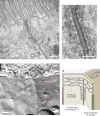A short guide to the tight junction
- PMID: 38712627
- PMCID: PMC11128289
- DOI: 10.1242/jcs.261776
A short guide to the tight junction
Abstract
Tight junctions (TJs) are specialized regions of contact between cells of epithelial and endothelial tissues that form selective semipermeable paracellular barriers that establish and maintain body compartments with different fluid compositions. As such, the formation of TJs represents a critical step in metazoan evolution, allowing the formation of multicompartmental organisms and true, barrier-forming epithelia and endothelia. In the six decades that have passed since the first observations of TJs by transmission electron microscopy, much progress has been made in understanding the structure, function, molecular composition and regulation of TJs. The goal of this Perspective is to highlight the key concepts that have emerged through this research and the future challenges that lie ahead for the field.
Keywords: Actin; Barrier; Cingulin; Claudin; Epithelium; Myosin; Occludin; Permeability; Polarity; Tight junctions; ZO-1.
© 2024. Published by The Company of Biologists Ltd.
Conflict of interest statement
Competing interests The authors declare no competing or financial interests.
Figures



References
Publication types
MeSH terms
Grants and funding
LinkOut - more resources
Full Text Sources
Research Materials

